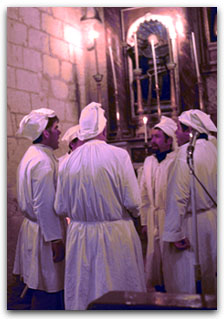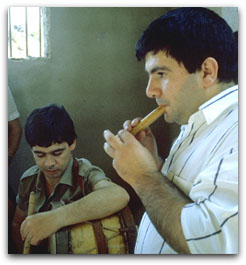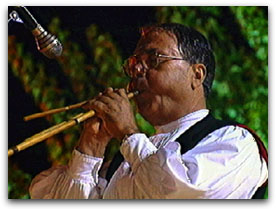
 Coro Confraternita di Castelsardo Coro Confraternita di Castelsardo |
|
The improvisation of
extemporary poets is often accompanied by a guitar player.
Extremely important is the "repertoire"
of songs sung by choral groups and of LITURGICAL AND PROCESSIONAL SONGS.
The latter are still
alive thanks to the works of the religious brotherhoods in centres such as Castelsardo, Cuglieri,
Santulussurgiu and Orosei and one can hear the insertion of the polyphonic folk style on a musical
form of well-educated or liturgical origin, in particular of Gregorian and Byzantine tradition.
The "repertoire" (based on Latin texts from the official liturgy) needs four specialised singers (as in
the case of tenores) and the songs are performed during Holy week ceremonies or, where the
Castelsardo cantores are concerned, also for the funeral rites of the brothers.
|
Castelsardo, a small centre
in the north of the island, is one of the most significant examples not only for the presence
of a large circle of specialised singers but mostly for the abundance of the repertoire and for
the peculiarity of the ceremonies held during Holy week. The French ethno-musicologist
Bernard Lortat Jacob has recently published an exhaustive volume on the tradition of
religious songs in the centre. Songs such as "Stabat mater" or "Miserere" and also
gotzos (gosos in logudorese dialect, goccious in campidanese dialect) are part of the
repertoire of these choral groups. In Sardinia these songs are used to praise the Holy
Virgin as well as to venerate the Holy Trinity or to commemorate the Saints' exemplar
lives and prodigies.
|
|

 Tumbarinu e pipiolu Tumbarinu e pipiolu |

 Luigi Lai from San Vito Luigi Lai from San Vito |
|
There is also a less rich secular
repertoire for rites connected to the cycle of the year.
The songs for; the new year's day offering,
the young singers, the shepherds or for those who are leaving are part of the repertoire of
"concordu" from Santulussurgiu. At other times of the year there are repertoires of songs for
religious events such as the festival for the patron Saint of Castelsardo.
|
The repertoire of NON-ACCOMPANIED
MONODIC SONGS is also very rich; some of them are extremely archaic such as the "aninnia"
(lullaby), the "duru duru" (from the Arabic duru which means to turn. These are nursery-rhymes
sung to children while bouncing them on one's knee), the "attitudu" or "attitu" (a mourning entrusted
solely to the female voice of the "mourning woman" accompanied by other women).
|
|